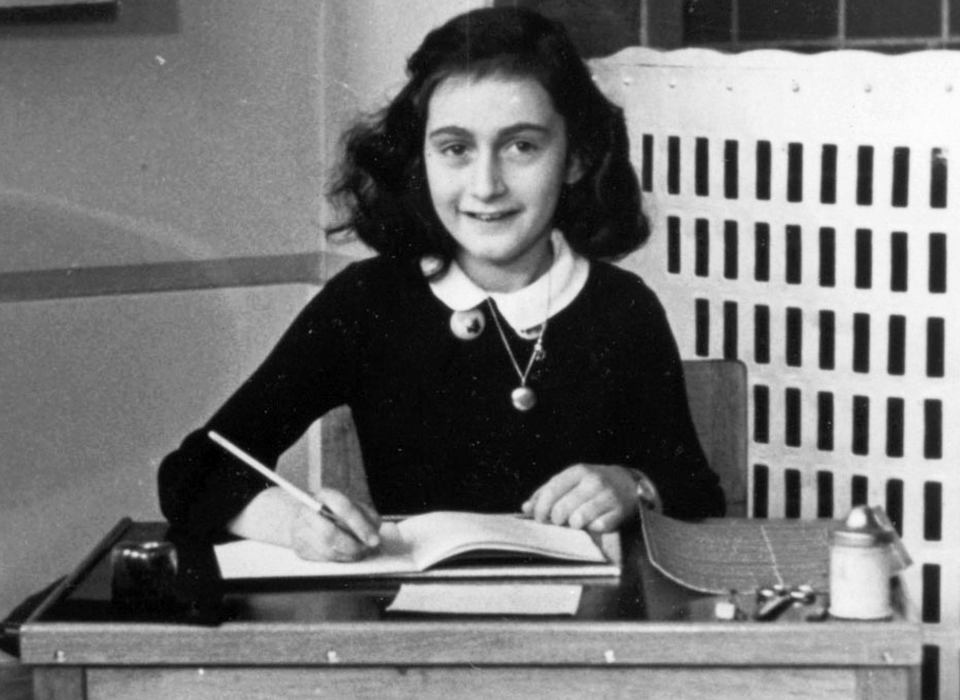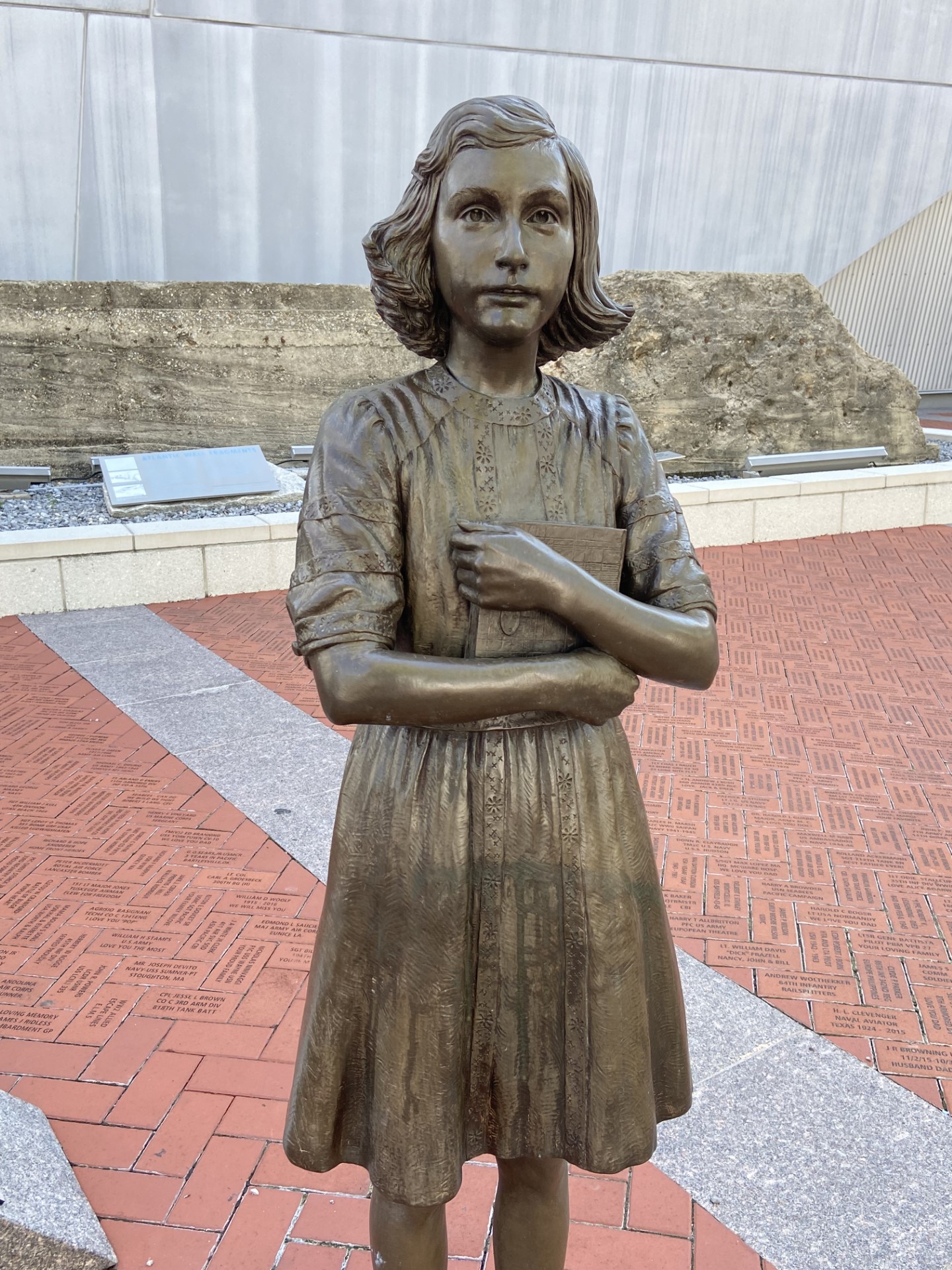Top Photo: Anne Frank in 1940, while at 6. Montessorischool, Niersstraat 41-43, Amsterdam (the Netherlands). Photograph by unknown photographer. Source Anne Frank Stichting, Amsterdam (Wikimedia Commons)
Anne Frank was born on June 12, 1929, to Otto and Edith Frank in Frankfurt am Main, Germany, where she lived until she was four years old. She had one sister, Margot, three years her elder. Otto Frank came from an upper-middle-class German-Jewish family in Frankfurt, and Edith, also Jewish, was the daughter of a wealthy industrialist from Aachen. While living in Germany, the Frank family saw the effects of the Great Depression firsthand, including rampant inflation and soaring unemployment. They witnessed, too, the rise of National Socialism and the appointment of Adolf Hitler as chancellor of Germany on January 30, 1933. To avoid persecution amid growing antisemitism in Germany, Otto Frank moved to Amsterdam in the summer of 1933 and established two companies specializing in the production of spices, pectin, and other foodstuffs. Edith and Margot followed shortly thereafter, and Anne, who had been living with her grandmother in Aachen, joined the rest of her family at the beginning of 1934.
Until the Nazi invasion of the Netherlands, Anne enjoyed a normal childhood in Amsterdam. The Franks lived in the middle-class Jewish neighborhood of Merwedeplein in the southern part of the city, and Anne easily acculturated to Dutch society. She quickly learned Dutch, made new friends, and went to a Dutch school near her home until she was in sixth grade before being accepted into the Jewish Lyceum where Margot also attended school. Anne did exceptionally well in school, getting along with her teachers and enjoying learning (except for math). The first month of diary entries provides insight into Anne’s daily life before going into hiding, detailing friendships, afterschool activities, such as playing ping pong and frequenting ice cream parlors, and encounters with several admirers.
On May 10, 1940, German forces invaded the Netherlands. The Dutch armed forces held out for four days, but by the end of May, the Nazis had installed a civilian-led government under the leadership of the Austrian Nazi Arthur Seyss-Inquart. During the occupation, the Nazis slowly introduced scores of antisemitic laws and regulations. As Anne describes in her diary, in addition to wearing a yellow star, the freedom of Jewish people in the Netherlands was severely restricted: Jews were no longer allowed to use streetcars, bicycles, or ride in cars; were forbidden from enjoying any form of public entertainment and from socializing with the non-Jewish population; could only frequent Jewish-owned businesses; and had to adhere to a strict curfew.
Amid these stringent decrees, there were also rumors that all Jews would eventually have to leave the Netherlands, which prompted Otto Frank to begin furnishing a hiding place in the annex of his business premises at Prinsengracht 263. Beginning in the first half of 1942, Otto converted the annex of his office building into a living space large enough to accommodate the entire Frank family as well as Herman van Pels, a work colleague and close friend of the Frank family; his wife, Auguste; and their teenage son, Peter. Later, Friedrich Pfeffer, a Jewish dentist known as Albert Dussel in Anne’s writings, joined them. Assisting them was a small, loyal cohort of trusted employees who provided food, supplies, information, and critical support to the annex’s residents for over two years. These “helpers,” as they would be referred as in Anne’s diary, included Miep Gies, Johannes Kleiman, Victor Kugler, Johan Voskuijl, and Elizabet “Bep” Voskuijl.
In late June 1942, the chief German administrator of the Central Agency for Jewish Emigration in Amsterdam informed the local Jewish population that within a few weeks, deportations from the Netherlands would commence. He instructed the Jewish Council to compile a list of thousands of Jews to be transferred to Germany for “labor service.” Margot Frank, then 16 years old, was on the first list of 4,000 Jews designated for deportation during the first week of July. While the Franks and van Pels had not planned on moving into the “secret annex” until the end of the month, after Margot received her summons, both families quickly went into hiding.
Documenting the Holocaust
Anne chronicled the details of life in the “secret annex” in a diary that her parents had given her for her 13th birthday. Anne addressed the diary to a fictional friend named Kitty: in the absence of an intimate confidant, she wanted to write letters to a close personal friend to whom she could openly share her thoughts and feelings. As the war dragged on and life in hiding became increasingly isolating, Anne’s diary became her refuge. What began as practice in self-reflection became, in Eleanor Roosevelt’s words, a “poignantly clear” illustration of “the ultimate shining nobility” of the human spirit.
Anne’s diary provides a crucial firsthand account of the experience of Dutch Jews during the Holocaust.
At the beginning of Nazi occupation, there were over 140,000 Jews living in the Netherlands, mostly concentrated in Amsterdam and other larger cities such as Rotterdam and The Hague. During the war, between 20,000 and 30,000 Dutch Jews went into hiding, with an estimated 16,000 to 17,000 surviving the war. According to the historical educator Jennifer Foray: “These numbers alone indicate that life in hiding, although hardly a guarantee of survival, constituted an integral wartime experience for Jews in the occupied Netherlands.”
Anne’s intimate and personal account of the Holocaust in the Netherlands not only depicts certain key events experienced by the eight people living in the annex, but also demonstrates human courage and frailty. Strewed with metaphors of a coming storm, her writing oscillates between optimism and hope on the one hand, and desperation and despair on the other, giving the reader a sense of what it was like to live under constant fear of detection. As Alex Sagen argues, Anne’s diary occupies a “uniquely prominent place” in Holocaust literature, because it brings readers close to grasping the suffering of European Jews during World War II. Moreover, “she draws particular attention to the difficulty of developing and maintaining one’s ideals in a world which seems to undermine all idealism.”
Anne’s diary is also a timeless coming-of-age narrative, which makes her story accessible to all. As she navigates adolescence, Anne documents her life growing up as a young teenager between the ages of 13 and 15 years old, frequently writing about self-criticism and personal development, dreams and cherished hopes, friendships, relationships with the opposite sex, and intergenerational conflict—all while under the constant threat of death. As a result, her diary has become a seminal first-person account of the Holocaust as well as an established piece of 20th-century literature.
Anne Frank’s Legacy
On March 8, 1944, Anne and the other members of the annex listened on their illegal radio to a speech given by Gerrit Bolkestein, the Dutch Education Minister (in exile), who stated: “History cannot be written on the basis of official decisions and documents alone. If our descendants are to understand fully what we as a nation have had to endure and overcome during these years, then what we really need are ordinary documents.”
“Not until we succeed in bringing together vast quantities of this simple, everyday material,” he continued, “will the picture of our struggle for freedom be painted in its full depth and glory.” After hearing Bolkestein’s call for Dutch citizens to record their wartime experiences, Anne began editing, revising, and condensing her diary with the goal of publishing it after the war.
Anne’s project was cut short, however, on the morning of August 4, 1944, when German and Dutch police raided the annex and arrested all eight inhabitants along with Viktor Kugler and Johannes Kleiman, who had been assisting the group while in hiding. After being held in a prison in Amsterdam and the Westerbork transit camp, Anne and the other members from the secret annex were deported to Auschwitz-Birkenau on September 3, 1944. They were part of the very last transport to leave from Westerbork.
Upon arrival in Auschwitz, close to 350 people from the transport were immediately selected and taken to the gas chambers. Anne, Margot, and Edith were sent to the labor camp for women while Otto was imprisoned in a camp for men. Otto Frank was the only member of the annex group to survive the war. Both Hermann van Pels and Edith Frank died in Auschwitz—Hermann shortly after his arrival in the autumn of 1944 and Edith from starvation and exhaustion on January 6, 1945, just three weeks before the Soviets liberated the camp. Friedrich Pfeffer died on December 20, 1944, in the Neuengamme concentration camp, and Peter van Pels perished on May 2, 1945, in Mauthausen. In November 1944, Anne and Margot were deported to the Bergen-Belsen concentration camp, where they both died from typhus sometime in February or March 1945. The date and location of Auguste van Pels’ death are unknown.
Following the raid on the “secret annex,” Miep Gies, the Frank family’s main link to the outside world, retrieved several items from the annex, including Anne’s diary, which she held onto for safekeeping. When Otto Frank returned to Amsterdam, Miep gave him all the belongings she had kept, including all of Anne’s writings. Respecting his daughter’s intention to publish her writings, Otto published Anne’s diary in Dutch in June 1947. Its first German translation was published in 1950 and, in 1952, Anne Frank: The Diary of a Young Girl was published in English. It quickly became an international bestseller and a cultural phenomenon.
A work published to combat racism and discrimination, Anne Frank’s diary is one of the world’s most widely read books and has been translated into 65 languages. Her story has also been adapted into numerous films, stage productions, and a graphic biography, making her, despite her terrible fate, an iconic figure and establishing her as the most well-known victim of Nazi persecution. In Anne Frank: The Book, the Life, the Afterlife, Francine Prose argues that Frank’s diary “should be awarded its place among the great memoirs and spiritual confessions, as well as among the most significant records of the era in which she lived.” Indeed, Anne Frank and her story have become part of the world’s collective memory of the Holocaust.
References:
- Anne Frank House, www.annefrank.org/en, (accessed August 17, 2023).
- Anne Frank, The Diary of a Young Girl: The Definitive Edition, ed. by Mirjam Pressler, trans. by Susan Massotty, mass market edition, (New York: Bantam Books, 2021).
- Jennifer L. Foray, “The Nation Behind the Diary: Anne Frank and the Holocaust of the Dutch Jews,” The History Teacher 44 no. 3 (May 2011): 329-352.
- Francine Prose, Anne Frank: The Book, the Life, the Afterlife, reprint edition, (New York: Harper Perennial, 2010).
- Alex Sagen, “An Optimistic Icon: Anne Frank’s Canonization in Postwar Culture,” German Politics & Society 13, no. 3 (36) (Fall 1995): 95-107.
Jennifer Popowycz, PhD
Jennifer Popowycz, PhD is the Leventhal Research Fellow at The National WWII Museum. Her research focuses on the Eastern Front and Nazi occupation policies in Eastern Europe in World War II.











